
Buckingham Palace is a royal residence in London and the administrative headquarters of the monarch of the United Kingdom. Located in the City of Westminster, the palace is often at the centre of state occasions and royal hospitality. It has been a focal point for the British people at times of national rejoicing and mourning.

Alexandra of Denmark was Queen of the United Kingdom and the British Dominions, and Empress of India, from 22 January 1901 to 6 May 1910 as the wife of King-Emperor Edward VII.
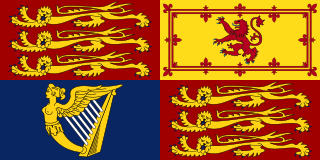
The Royal Standards of the United Kingdom presently refer to either of two similar flags used by King Charles III in his capacity as Sovereign of the United Kingdom, the Crown dependencies, and the British Overseas Territories. Two versions of the flag exist, one for use within Scotland and the other for use elsewhere.
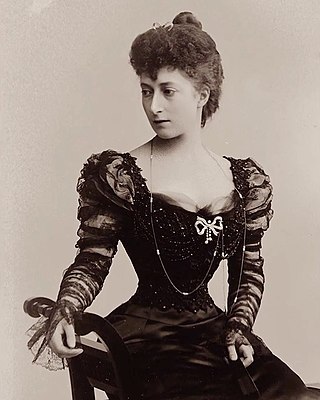
Maud of Wales was Queen of Norway as the wife of King Haakon VII. The youngest daughter of King Edward VII and Queen Alexandra of the United Kingdom, she was known as Princess Maud of Wales before her marriage, as her father was the Prince of Wales at the time.
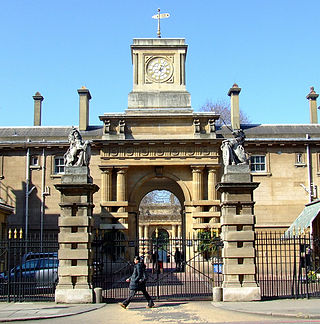
The Royal Mews is a mews, or collection of equestrian stables, of the British royal family. In London these stables and stable-hands' quarters have occupied two main sites in turn, being located at first on the north side of Charing Cross, and then within the grounds of Buckingham Palace.
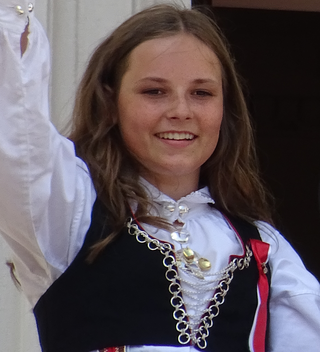
Princess Ingrid Alexandra of Norway is the eldest child of Crown Prince Haakon and Crown Princess Mette-Marit, and the grandchild of King Harald V. She is second in line of succession to the Norwegian throne after her father. She is expected to become the country's second female monarch, after the 15th-century Queen Margaret.

The Irish State Coach is an enclosed, four-horse-drawn carriage used by the British Royal Family. It is the traditional horse-drawn coach in which the British monarch travels from Buckingham Palace to the Palace of Westminster to formally open the new legislative session of the UK Parliament.

The Gold State Coach is an enclosed, eight-horse-drawn carriage used by the British royal family. Commissioned in 1760 by Francis Rawdon-Hastings, 1st Marquess of Hastings for King George III, and designed by Sir William Chambers, it was built in the London workshops of Samuel Butler. It was commissioned for £7,562. It was built for George III's coronation in 1761, but was not ready in time; it was completed in 1762.
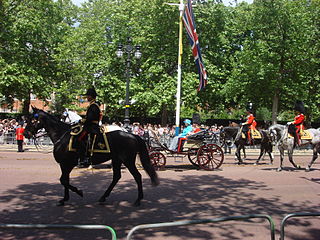
The Crown Equerry is the operational head of the Royal Mews of the Royal Household of the Sovereign of the United Kingdom. As executive head of the Royal Mews Department, he is responsible for the provision of vehicular transport for the sovereign, both cars and horse-drawn carriages. Train travel is arranged by the Royal Travel Office, which also co-ordinates air transport.

The Bentley State Limousines are official state cars manufactured by Bentley as a gift for the late Queen Elizabeth II on the occasion of her Golden Jubilee in 2002. The two cars produced were in service for the Queen up until her death in 2022. They have most recently been in service for King Charles III. The Princess Royal used the car while accompanying the Queen's coffin. Both cars are kept in the Royal Mews.

The Scottish State Coach is an enclosed, four-horse-drawn carriage used by the British Royal Family.

The Australian State Coach is an enclosed, six horse-drawn coach used by the British Royal Family. Constructed in 1986-88, it was the first royal state coach to have been built since 1902. It was presented to Queen Elizabeth II of Australia and the United Kingdom in Canberra on 8 May 1988, as the official gift on the occasion of the Australian Bicentennial, and was first used in November of that year by the Queen at the State Opening of Parliament in the UK.

The Diamond Jubilee State Coach is an enclosed, six-horse-drawn carriage that was made to commemorate Queen Elizabeth II's 80th birthday, but completion was delayed for nearly eight years. Eventually, it became a commemoration for the Queen's Diamond Jubilee.

The monarchy of Denmark is a constitutional institution and a historic office of the Kingdom of Denmark. The Kingdom includes Denmark proper and the autonomous territories of the Faroe Islands and Greenland. The Kingdom of Denmark was already consolidated in the 8th century, whose rulers are consistently referred to in Frankish sources as "kings". Under the rule of King Gudfred in 804 the Kingdom may have included all the major provinces of medieval Denmark.
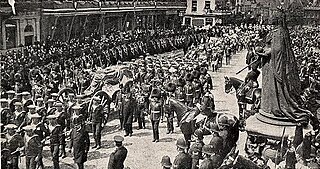
The state funeral of Edward VII, King of the United Kingdom of Great Britain and Ireland and Emperor of India, occurred on Friday, 20 May 1910.
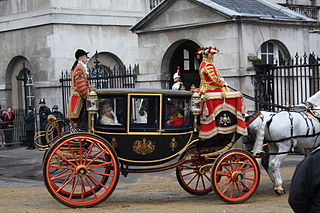
The Glass Coach is one of the principal State carriages of the British monarch. Built by Peters & Sons of London in 1881, it had originally been designed as a sheriff's coach, but was purchased by the Crown in time for the coronation of George V in 1911.
The State Opening of Parliament includes a State Procession, a formal display of the Sovereign, dignified by a sizeable entourage made up of Great Officers of State and members of the Royal Household. The State Procession is now confined to the interior of the Palace of Westminster, but in earlier centuries it followed an outdoor route to and from Westminster Abbey.

The Royal Stables is the mews of the Swedish Monarchy which provides both the ceremonial transport for the Swedish Royal Family during state events and festive occasions and their everyday transportation capacity. The Royal Stables date from 1535, and were originally built on Helgeandsholmen, close to Stockholm Palace. The Royal Stables are today located just behind Strandvägen in Östermalm in central Stockholm, Sweden. The head of the Royal Stables is the Crown Equerry.

The state and royal cars of the United Kingdom are kept at the Royal Mews, Buckingham Palace, where a wide range of state road vehicles are kept and maintained. The vehicles also are stored at other royal residences as required.
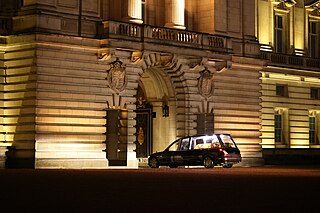
The state hearse is a vehicle of the Royal Mews used for funerals of the British royal family. Based on a Jaguar XJ model, it was designed by the Royal Household and Jaguar Land Rover with the input of and approval from Elizabeth II and converted by UK-based coachbuilders Premiere Sheet Metal, while Wilcox Limousines created the interior, exterior trim and glazing. It was first used on 13 September 2022 to transport the Queen's coffin from RAF Northolt to London ahead of her lying-in-state




















